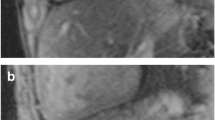Abstract
The goal of this study was to assess the ability of quantitative T1 cardiovascular magnetic resonance (CMR) imaging to calculate liver extracellular volume (ECV) in patients with varying degrees of congestive hepatopathy (CH). T1 measurements and ECV calculations were performed retrospectively in three cohorts of patients: normal cardiac function, tetralogy of fallot (TOF) repair and Fontan palliation. All CMR studies included modified look-locker inversion recovery (MOLLI) T1 map** scans performed pre- and post-injection of a gadolinium-based contrast agent (GBCA). Pixel intensity data were manually collected from images of the liver and cardiac blood pool to determine contrast-induced changes in T1 for liver and blood. These data were then used to compute liver ECV. 172 subjects were included in the study. Of these, 140 subjects were normal cardiac function patients, 16 were TOF repair patients and 16 patients were with Fontan palliation. A statistically significant difference in both the liver native T1 and ECV measurements was found between patients with normal cardiac function vs. Fontan palliation patients (p < 0.01). Our data indicate that measuring T1 maps both pre- and post-GBCA injection within CMR scan session can be used to follow progression of liver fibrosis. This technique has the potential to improve diagnosis and treatment of patients with chronic liver disease and liver fibrosis.




Similar content being viewed by others
Abbreviations
- CMR:
-
Cardiovascular magnetic resonance
- ECV:
-
Extracellular volume
- CH:
-
Congestive hepatopathy
- TOF:
-
Tetralogy of Fallot
- MOLLI:
-
Modified look-locker inversion recovery
- GBCA:
-
Gadolinium-based contrast agent
- MR:
-
Magnetic resonance
- HCT:
-
Haematocrit
- SD:
-
Standard deviation
- ROC:
-
Receiver operator characteristic
- DMD:
-
Duchenne muscular dystrophy
- PHVC:
-
Passive hepatic venous congestion
- AUC:
-
Area under curve
- PACS:
-
Picture archiving computer system
References
Dennis M, et al. (2017) Adults with repaired tetralogy: low mortality but high morbidity up to middle age. Open Heart 4(1):e000564
Wells ML, et al. (2016) Imaging findings of congestive hepatopathy. Radiographics 36(4):1024–1037
Simonetto DA, et al. (2015) Chronic passive venous congestion drives hepatic fibrogenesis via sinusoidal thrombosis and mechanical forces. Hepatology 61(2):648–659
Bandula S, et al. (2015) Equilibrium contrast-enhanced CT imaging to evaluate hepatic fibrosis: initial validation by comparison with histopathologic sampling. Radiology 275(1):136–143
Li XM, et al. (2017) Diagnostic value of gadobenate dimeglumine-enhanced hepatocyte-phase magnetic resonance imaging in evaluating hepatic fibrosis and hepatitis. World J Gastroenterol 23(17):3133–3141
Ratziu V, et al. (2005) Sampling variability of liver biopsy in nonalcoholic fatty liver disease. Gastroenterology 128(7):1898–1906
Regev A, et al. (2002) Sampling error and intraobserver variation in liver biopsy in patients with chronic HCV infection. Am J Gastroenterol 97(10):2614–2618
Arthur MJ (2002) Reversibility of liver fibrosis and cirrhosis following treatment for hepatitis C. Gastroenterology 122(5):1525–1528
Towbin AJ, Serai SD, Podberesky DJ (2013) Magnetic resonance imaging of the pediatric liver: imaging of steatosis, iron deposition, and fibrosis. Magn Reson Imaging Clin N Am 21(4):669–680
Messroghli DR, et al. (2004) Modified Look-Locker inversion recovery (MOLLI) for high-resolution T1 map** of the heart. Magn Reson Med 52(1):141–146
Lee JJ, et al. (2011) Myocardial T1 and extracellular volume fraction map** at 3 Tesla. J Cardiovasc Mag Reson 13:75
Chow AM, et al. (2012) Measurement of liver T1 and T2 relaxation times in an experimental mouse model of liver fibrosis. J Mag Reson Imaging 36(1):152–158
Kawel-Boehm N, et al. (2015) Normal values for cardiovascular magnetic resonance in adults and children. J Cardiovasc Magn Reson 17:29
Jae SY, et al. (2014) Higher blood hematocrit predicts hypertension in men. J Hypertens 32(2):245–250
Banerjee R, et al. (2014) Multiparametric magnetic resonance for the non-invasive diagnosis of liver disease. J Hepatol 60(1):69–77
Yin M, et al. (2016) Hepatic MR elastography: clinical performance in a series of 1377 consecutive examinations. Radiology 278(1):114–124
Xanthakos SA, et al. (2014) Use of magnetic resonance elastography to assess hepatic fibrosis in children with chronic liver disease. J Pediatr 164(1):186–188
Cassinotto C, et al. (2015) MR relaxometry in chronic liver diseases: comparison of T1 map**, T2 map**, and diffusion-weighted imaging for assessing cirrhosis diagnosis and severity. Eur J Radiol 84(8):1459–1465
Ding Y, et al. (2015) Liver fibrosis staging using T1 map** on gadoxetic acid-enhanced MRI compared with DW imaging. Clin Radiol 70(10):1096–1103
Serai SD, Towbin AJ, Podberesky DJ (2012) Pediatric liver MR elastography. Dig Dis Sci 57(10):2713–2719
Serai SD, Trout AT, Sirlin CB (2017) Elastography to assess the stage of liver fibrosis in children: concepts, opportunities, and challenges. Clin Liver Dis 9(1):5–10
Serai SD, et al. (2014) Magnetic resonance elastography of the liver in patients status-post fontan procedure: feasibility and preliminary results. Congenit Heart Dis 9(1):7–14
Acknowledgements
We would like to thank the Summer Undergraduate Research Fellowship (SURF) program at Cincinnati Children’s Hospital Medical Center.
Availability of data and material
The PACS system (Merge; Chicago, IL, USA) was searched for all patients who had a dedicated CMR examination.
Author information
Authors and Affiliations
Contributions
All authors read, critically edited the initial manuscript, added intellectual content and approved the final version. IMK, SDS and RJF designed, coordinated and conducted the study. IMK acquired all data and was mentored by SDS under the SURF program. SX assisted with study design and added critical manuscript content.
Corresponding author
Ethics declarations
Funding
This research was partially supported by a grant from the NIH, R01DK100429.
Conflict of interest
None.
Ethical approval
All procedures performed in studies involving human participants were in accordance with the ethical standards of the institutional and/or national research committee and with the 1964 Helsinki declaration and its later amendments or comparable ethical standards. This study was approved by the Institutional Review Board and all study procedures were performed in a HIPPA compliant manner.
Informed consent
This was a retrospective study and informed consent was waived by the IRB.
Rights and permissions
About this article
Cite this article
Kazour, I., Serai, S.D., Xanthakos, S.A. et al. Using T1 map** in cardiovascular magnetic resonance to assess congestive hepatopathy. Abdom Radiol 43, 2679–2685 (2018). https://doi.org/10.1007/s00261-018-1528-x
Published:
Issue Date:
DOI: https://doi.org/10.1007/s00261-018-1528-x




